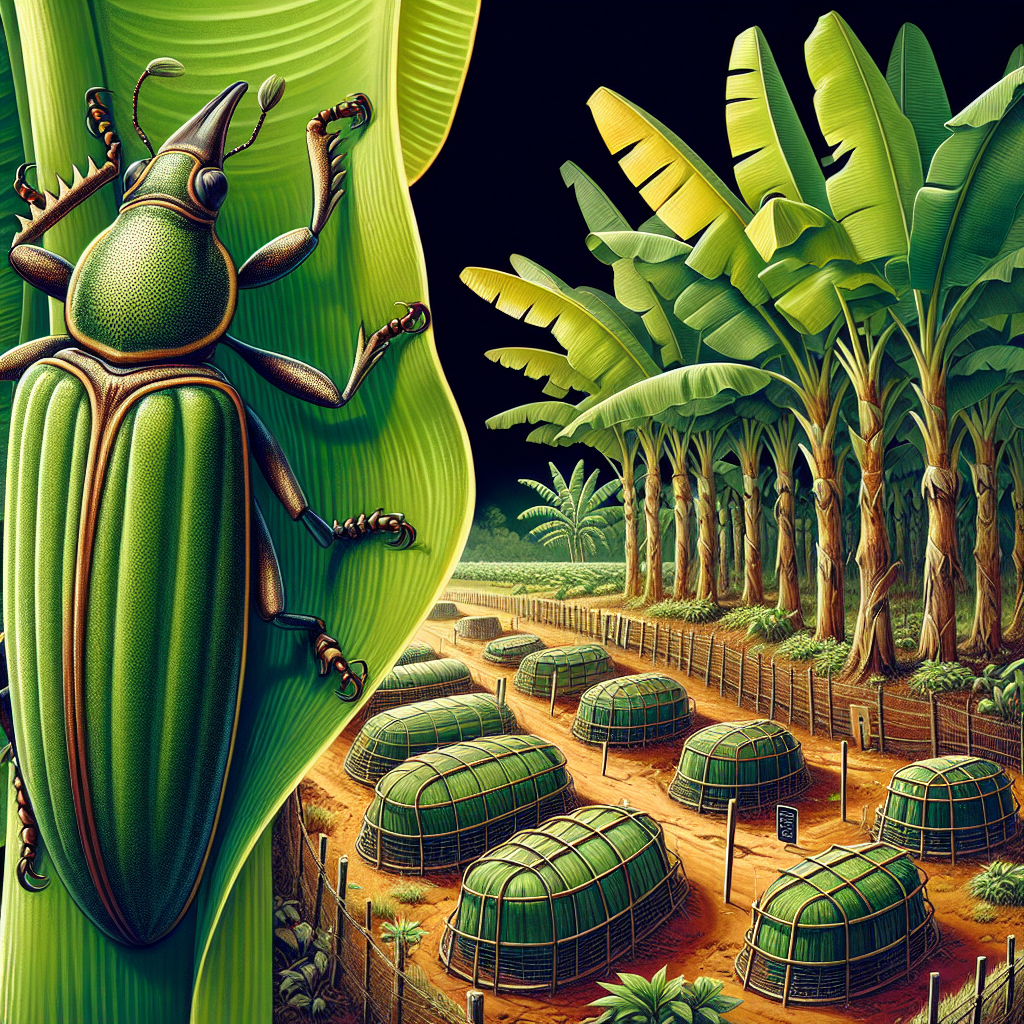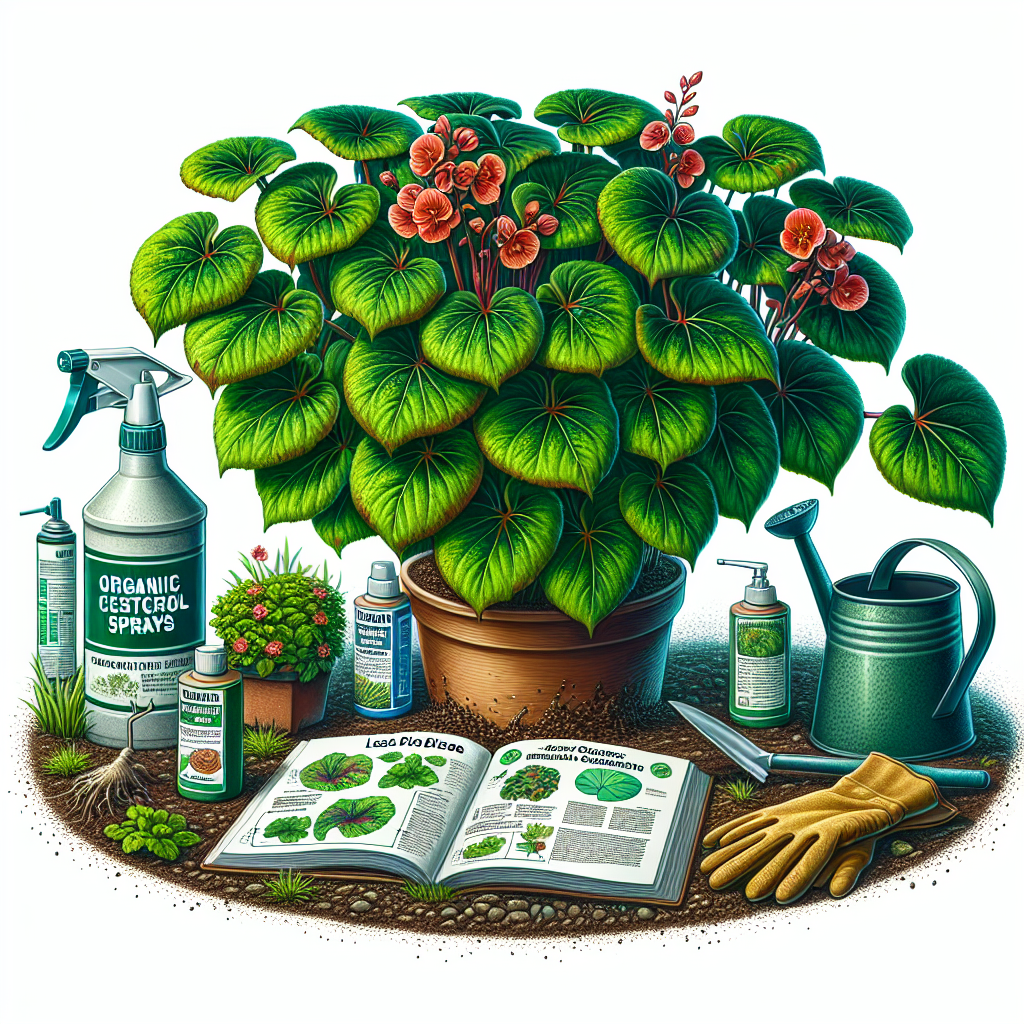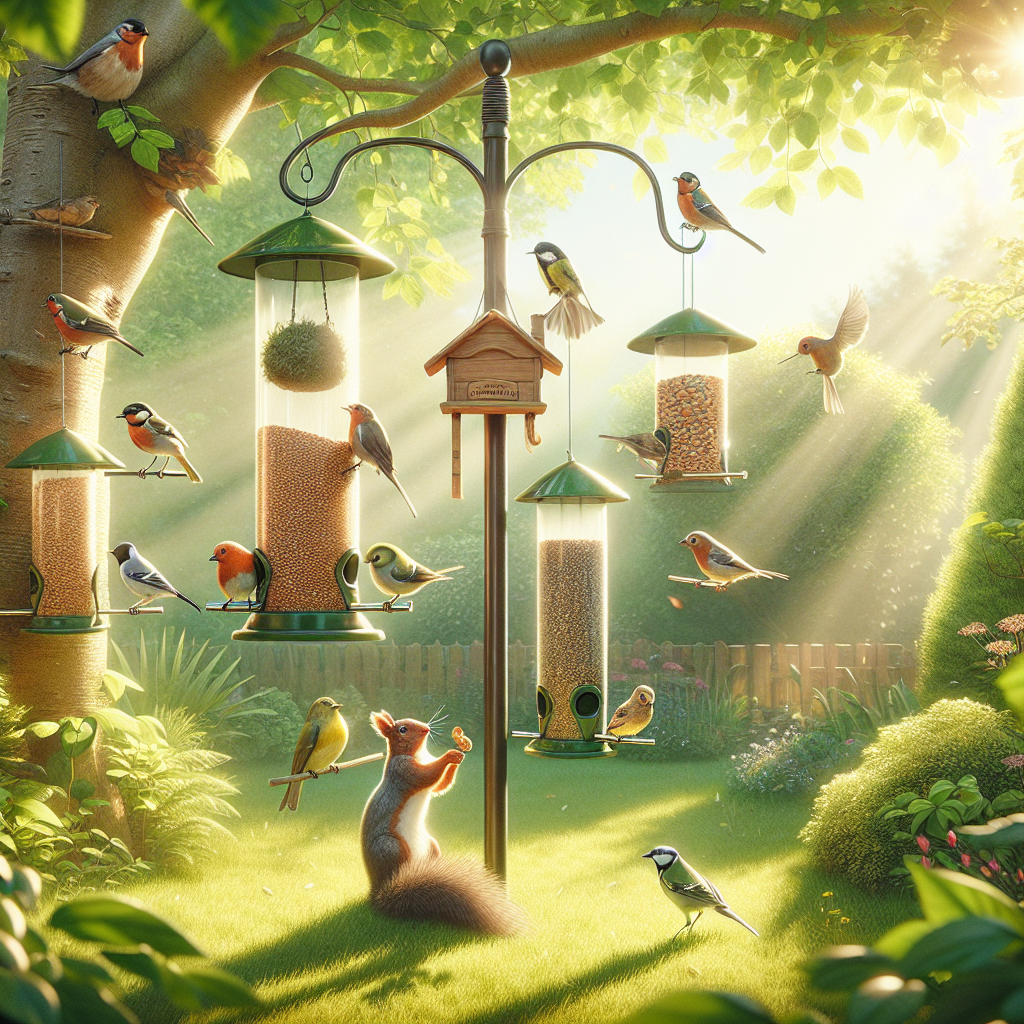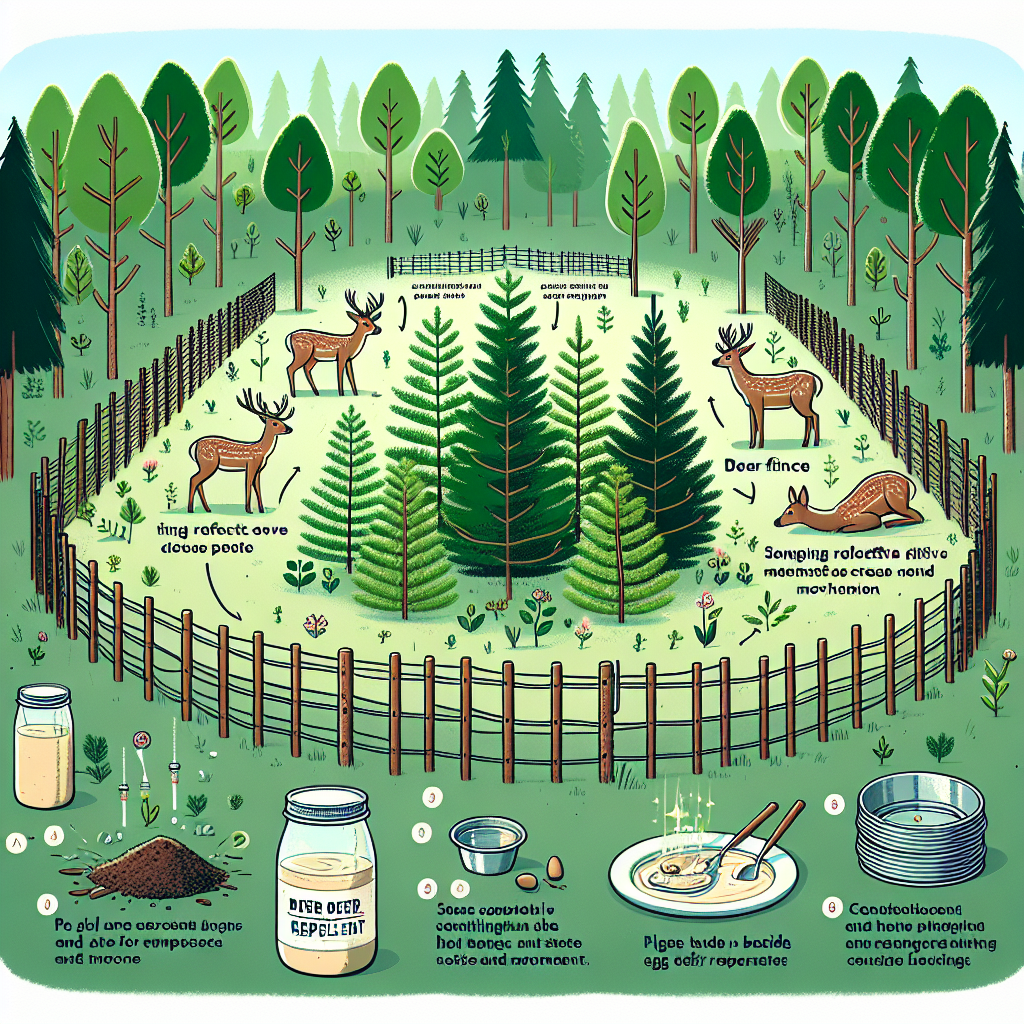Protecting Banana Plants from Banana Weevil
Published April 4, 2024 at 6:19 am
Discover effective strategies to shield your banana crops from the devastating impact of banana weevils, ensuring healthier plants and bountiful yields.

“`html
Understanding the Banana Weevil Threat
Banana weevils, known scientifically as Cosmopolites sordidus, are one of the most destructive pests affecting banana plants. It’s vital to understand the magnitude of threats posed by these little creatures. Not only do they cause physical damage to the plants, but they can also lead to significant economic losses.
The larvae of banana weevils bore into the corms of banana plants, interrupting the uptake of nutrients and water. This damage can weaken the plant, predispose it to diseases and, in severe cases, cause the entire plant to topple over. Hence, it’s crucial for anyone nurturing banana plants to be vigilant and proactive in managing this pest.
Identifying Banana Weevil Infestation
Spotting early signs of weevil infestation can save you a lot of trouble down the line. Look out for wilting plants, yellowing leaves, and the presence of adult weevils, which are about a quarter-inch long, shiny black, and have a distinctive snout. Another clear indicator is the presence of small circular holes at the base of the banana plant, especially near the corm.
The earlier you catch these signs, the better. It can mean the difference between a manageable problem and a widespread infestation that could threaten your entire banana plantation.
Preventative Measures and Cultural Control
Prevention is always the first line of defense when it comes to pests. Employing good farming practices can significantly reduce the risk of weevil infestation. This includes the removal and destruction of affected plants and corms, which should be done carefully to avoid spreading the larvae or adult weevils to healthy plants.
- Clean Farming Practices – Maintaining cleanliness around banana plants can deter weevil colonization. Regularly clear out any crop debris, as this can be a breeding ground for weevils.
- Trap Cropping – Plant trap crops around your banana plantation. Trap crops are sacrificial plants that are more attractive to the weevils than your bananas, thereby diverting the pest away from your main crop.
- Interplanting – Intercropping bananas with non-host plants can also be an effective way to confuse and deter banana weevils.
Biological Control Options
Biological methods involve using natural predators or parasites to control the banana weevil population. One example is the use of entomopathogenic nematodes, which can be applied to the soil around banana plants. These beneficial nematodes seek out and kill weevil larvae, thus protecting the banana plants, without the use of chemicals.
There have been several studies documenting the effectiveness of nematodes against banana weevils. When exploring this option, it’s important to choose a reliable product and apply it according to the manufacturer’s instructions to ensure efficacy.
Chemical Control and Pesticides
For those who have a severe infestation, chemical control may be necessary. However, pesticides should be used with caution and always according to the label’s instructions. It’s worth considering environmental-friendly pesticides or ones that are specifically designed to target banana weevils without affecting other beneficial insects or the surrounding ecosystem.
One such product that has been shown to be effective in managing banana weevils is ‘Pacer’ – a pyrethroid insecticide. Reviews state that its targeted action helps control the weevil population when applied correctly, causing minimal disturbance to beneficial fauna.
Find This and More on Amazon
Chemical-Free Solutions
For those who prefer to avoid chemicals entirely, there are non-chemical solutions such as pheromone traps and the use of botanical extracts. One botanical product that has been praised by organic farmers is ‘Neem Bliss’. Sourced from the neem tree, it is known to be effective against a wide range of pests, including the banana weevil.
Users have reported that ‘Neem Bliss’ can keep weevils at bay when used consistently. Its organic nature appeases those mindful of the environment and looking to maintain organic farming certifications.
Monitoring and Routine Check-ups
Regular monitoring of your banana plantation is indispensable. This involves routinely checking for signs of damage and the presence of weevils themselves. Establishing a regular schedule for inspections ensures that any infestation is detected early and can be dealt with promptly.
The use of pheromone traps is another product that could also be incorporated into your monitoring routine. These traps release chemicals that mimic those produced by female weevils, thereby attracting males and trapping them before they can mate. A well-known product in this category is the ‘WeevilCide Pheromone Trap.’
Addressing Affected Plants
If you discover infested plants, they should be dealt with immediately. It’s advised to cut down and remove these plants, ensuring you destroy the corm and any larvae or pupae found. This helps to halt the spread of the infestation to adjacent plants.
Remember to always sanitize your tools after dealing with infested plants to prevent accidental spread to other areas of your plantation.
Community Management Strategies
Banana weevil control is more effective when an entire community or farming region participates in management efforts. This usually involves synchronized planting and harvesting, which can help prevent the spread of weevils across different plantations.
Forming groups and collaborating with local agricultural extension services for coordinated pest control can also amplify the success of these strategies.
Resilient Plant Varieties
Another avenue for managing banana weevils is to grow resistant varieties. Scientists have been working on breeding banana plants that are less attractive to weevils or can tolerate infestation with minimal damage.
Those interested in this approach should consult agricultural research stations or universities to find out about the availability of resistant varieties suited to their specific climate and soil conditions.
Your Path to a Weevil-Free Plantation
Protecting banana plants from banana weevils is a multifaceted task requiring vigilance, dedication, and a willingness to implement various strategies. Combining preventative measures, biological and chemical control when necessary, and routine monitoring are keys to maintaining a healthy and productive banana plantation.
Embrace the principles of integrated pest management—combining cultural, biological, and chemical measures—for the most sustainable and effective defense against the dreaded banana weevil. By engaging with the broader farming community and staying informed on the latest research and resistant plant varieties, you can fortify your defenses against this pest.
Exploring More Plant Care Techniques
If you’re interested in expanding your knowledge on plant care, especially for those kept in low-light conditions, consider reading about caring for snake plants or the intricacies involved in growing peace lilies indoors. These insights can be incredibly valuable for those looking to ensure their plants thrive, even in challenging indoor environments.
Moreover, for individuals keen on maintaining air quality alongside plant health, exploring the benefits of English ivy for cleaner air at home might provide fascinating guidance. Plants can be both beautiful and functional, contributing to overall wellness in more ways than one.
“““html
Organic Management for Long-Term Success
When contemplating weevil management, many farmers seek sustainable organic methods to preserve the natural balance of their ecosystems. Considering the potential negative impacts of synthetic chemicals, exploring organic practices can be both environmentally and financially prudent.
An efficacious practice would include the use of organic mulches, which can not only enrich the soil but also help deter the banana weevil. Organic mulches, such as those composed of well-chosen composting material or agricultural waste, provide a physical barrier that can discourage weevil infestation.
Effective Weevil Trapping Techniques
Trapping is a cornerstone in the fight against banana weevils. By setting up effective traps, you can monitor weevil activity and reduce their population over time. Pseudostem traps, which are made from cut banana stems, can mimic the natural hiding places for weevils and are an excellent option for organic farmers.
The principle is simple: the cut pseudostem attracts weevils, which then become trapped inside. Regular inspection and dismantling of these traps are necessary to dispose of the captured pests properly.
Beneficial Microbes: A Natural Solution
An innovative approach involves introducing beneficial microbes into the soil to outcompete or inhibit the banana weevil. Biocontrol agents such as certain types of fungi, like Beauveria bassiana and Metarhizium anisopliae, have shown potential in controlling banana weevil populations.
Farmers interested in this method can purchase these biopesticides under various brand names. Rigorous adherence to the application guidelines can yield significant results over time, with the added benefit of being safe for non-target organisms.
Soil Health: The Foundation of Weevil Management
Healthy soil translates to robust plant defenses. By prioritizing soil health, you can boost the plant’s resilience to pests like the banana weevil. Integrating organic matter through compost or green manure can fortify the soil. It enhances nutrient availability, improves soil structure, and supports a vibrant ecosystem of beneficial organisms that can naturally suppress pest populations.
Moreover, periodic soil testing can reveal mineral deficiencies or pH imbalances, which, when addressed, contribute to stronger, more resistant banana plants.
Innovative Mechanical Controls
Mechanical control methods offer another tool in the banana grower’s arsenal against weevils. This includes practices like sanitizing cutting tools with bleach or alcohol between uses to prevent cross-contamination, and physical barriers such as plastic sleeves placed around the base of banana plants can deny weevils access to the corms.
Simple tweaks in farming equipment and methodology can have a significant impact on weevil management, making it a cost-effective and immediate option for many farmers.
Integrated Pest Management (IPM): A Holistic Approach
Integrated Pest Management (IPM) puts forth a comprehensive strategy that combines different control measures to address banana weevil infestations effectively. IPM emphasizes the importance of understanding the lifecycle and behavior of the targeted pest, in this case, the banana weevil, and combines this knowledge with cultural, mechanical, biological, and chemical controls as needed.
IPM aims to minimize harm to the environment and human health while managing pests efficiently. A successful IPM plan could include rotating insecticides with different modes of action to prevent resistance, deploying pheromone traps, and engaging in cultivation practices that reduce pest habitat.
Staying Informed: Education and Research
For any grower, being well-informed is crucial. Engaging with the latest research on banana weevil management can introduce you to new methods and technologies. For example, you might discover new resistant banana cultivars or innovative biopesticides. Reaching out to local agricultural extensions or universities can provide valuable resources and support.
Subscribing to agricultural journals, attending farming workshops, and collaborating with other banana growers are proactive steps toward maintaining a healthy banana plantation in the presence of banana weevils.
Final Thoughts on Banana Weevil Control
Combating the banana weevil is undoubtedly challenging, but with the right combination of strategies, it’s a battle that can be won. Remember to remain vigilant, regularly inspect your banana plants, and be willing to adapt and experiment with different approaches for the best results. Ultimately, it’s about creating a sustainable, balanced ecosystem where your banana plants can flourish without being compromised by the banana weevil.
Resilience and adaptability are key. By integrating different methods tailored to your specific situation and being open to evolving your approach as needed, your banana plants will stand a much better chance against the persistent threat of the banana weevil.
Additional Resources and Support
If you’ve found these strategies fascinating and wish to delve deeper into other aspects of plant care, the nuances of nurturing a ZZ plant in low-light environments or the considerations for maintaining Dracaena might also pique your interest.
In addition, for those passionate about vegetable gardening, the tips provided in harvesting your vegetable garden can be invaluable. Proper care and management extend across all types of plants and understanding the principles can benefit the overall health and productivity of your garden endeavors.
“““html
Personal Experiences with Weevil Management
When it comes to managing weevils, each grower’s experience can offer unique insights. There’s no one-size-fits-all solution, as conditions vary widely between climates, soil types, and the specific challenges presented by the local weevil population.
It’s said that some farmers have had great success with regular applications of organic soil amendments, while others swear by the strategic use of pheromone traps. Such shared experiences often become invaluable, passed down through generations of farmers or across forums and community groups.
Financial Considerations
It’s crucial to consider the financial impact of weevil management. The right strategies can save not only your banana plants but also your hard-earned profits. For many growers, especially those in developing countries, budget-friendly solutions are vital.
Implementing cost-effective cultural practices and creating DIY traps from local materials may offer substantial savings over expensive chemical treatments. Even when finances allow for more advanced solutions, it’s always wise to weigh the cost against the potential benefits.
Community Success Stories
Success in combating the banana weevil isn’t just down to individual efforts. In various parts of the world, community-wide strategies have proved highly successful. These often include collective actions like synchronized sanitation practices and the sharing of information and resources.
Communities that develop a unified approach to banana weevil management often see a significant decrease in pest numbers, leading to healthier plants and more abundant harvests for all involved.
Evaluating Different Products and Methods
Evaluating different products and methods for weevil control isn’t just practical; it’s a necessity for the discerning farmer. A product that’s been gaining traction among growers is ‘Weevil Stop,’ a natural repellent that promises to deter weevils without harming beneficial insects or soil health.
According to reviews, ‘Weevil Stop’ has been effective for many, especially when implemented as part of a broader integrated pest management plan. Its ease of use and non-toxic formula are often highlighted as major pluses.
Find This and More on Amazon
Tips for New Banana Plant Growers
If you’re a new banana plant grower facing the daunting prospect of weevil management, fear not. There’s a wealth of knowledge and tried-and-tested techniques at your disposal. Start with the basics, learning to recognize early signs of infestation and understanding the lifecycle of the weevil.
Don’t hesitate to reach out to local farming cooperatives or agricultural officers who can provide guidance and possibly connect you with mentorship opportunities. Learning from the experiences and mistakes of others can accelerate your journey towards becoming a weevil-wise banana grower.
Embracing Sustainable Practices
In any discussion about pest control, sustainability should be at the forefront. By employing sustainable practices, not only are you protecting your banana plants against weevils, but you’re also ensuring the health of your farm’s ecosystem for the long term.
Sustainable practices may include rotating crops to break pest life cycles, enhancing on-farm biodiversity, and using organic matter to promote beneficial insect populations which can serve as natural pest control agents.
Future Directions in Weevil Control
As research continues and technology advances, new directions in weevil control are emerging. Novel biopesticides, genetically resistant banana varieties, and even robotic monitoring systems may soon be part of the modern farmer’s toolkit.
Staying abreast of these developments is not just exciting; it could prove critical to the future success and sustainability of banana agriculture in weevil-prone regions.
Expert Insights
Lastly, don’t overlook the value of expert insights when battling banana weevils. Agronomists, entomologists, and seasoned farmers can offer perspective on the latest control methods, provide case studies, and suggest nuanced adjustments to your weevil management strategies.
Experts can also help tailor pest control plans to your specific environmental conditions and farming goals, ensuring that every action you take against the weevils is both efficient and effective.
Closing Thoughts on Weevil Management
In conclusion, protecting banana plants from weevils is an ongoing process that entails a diverse range of actions—from vigilance in monitoring to strategic implementation of control measures. By approaching this challenge with a well-rounded perspective and a readiness to learn and adapt, you can safeguard your plantation against the damaging impact of banana weevils.
The goal is a thriving, weevil-free banana plantation that not only supports your livelihood but also contributes to the broader health of the agricultural ecosystem. Embrace the journey, and with the right knowledge and tools, success is within reach.
“`
Shop more on Amazon
Flowers & Plants Team
Flowers & Plants Team


